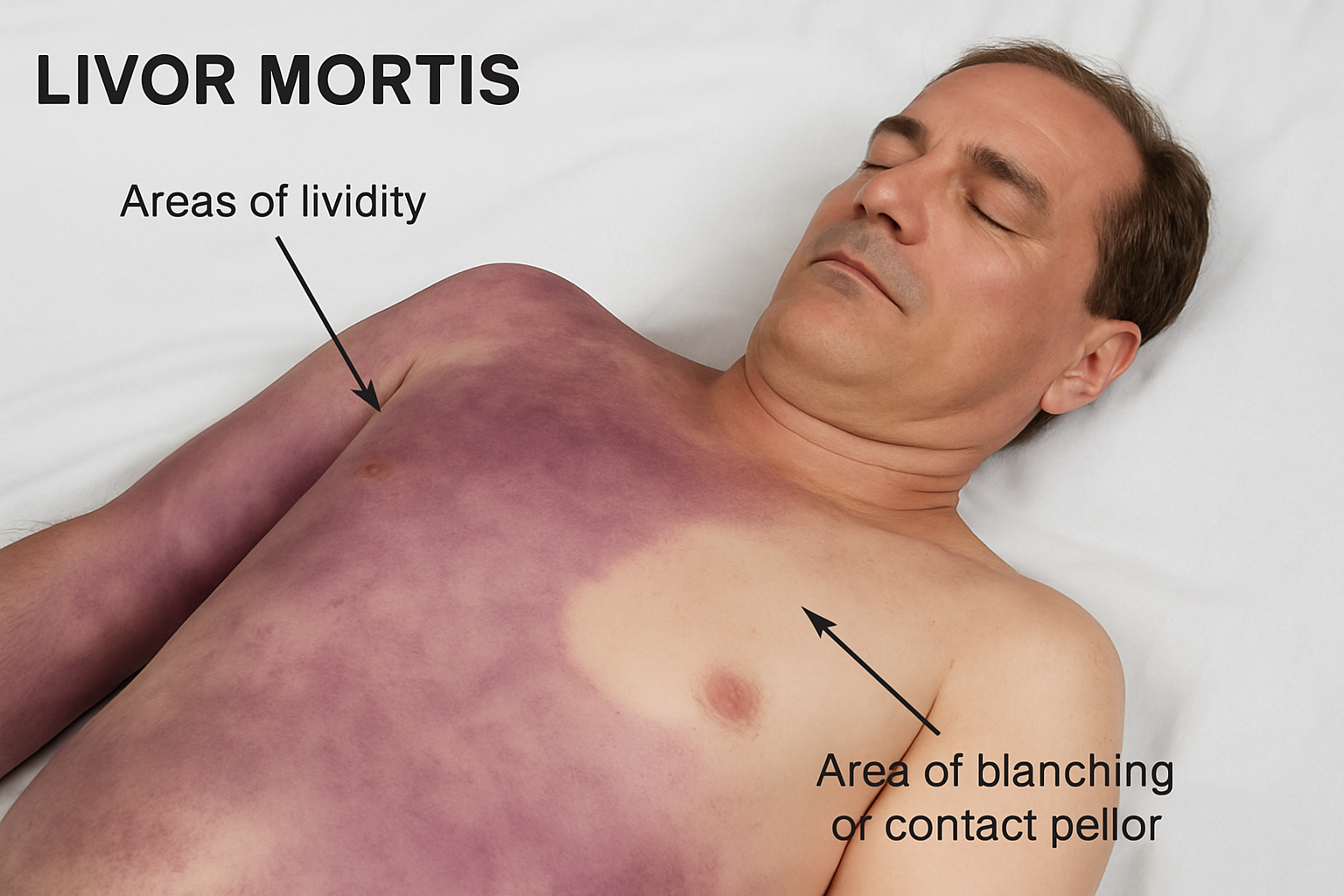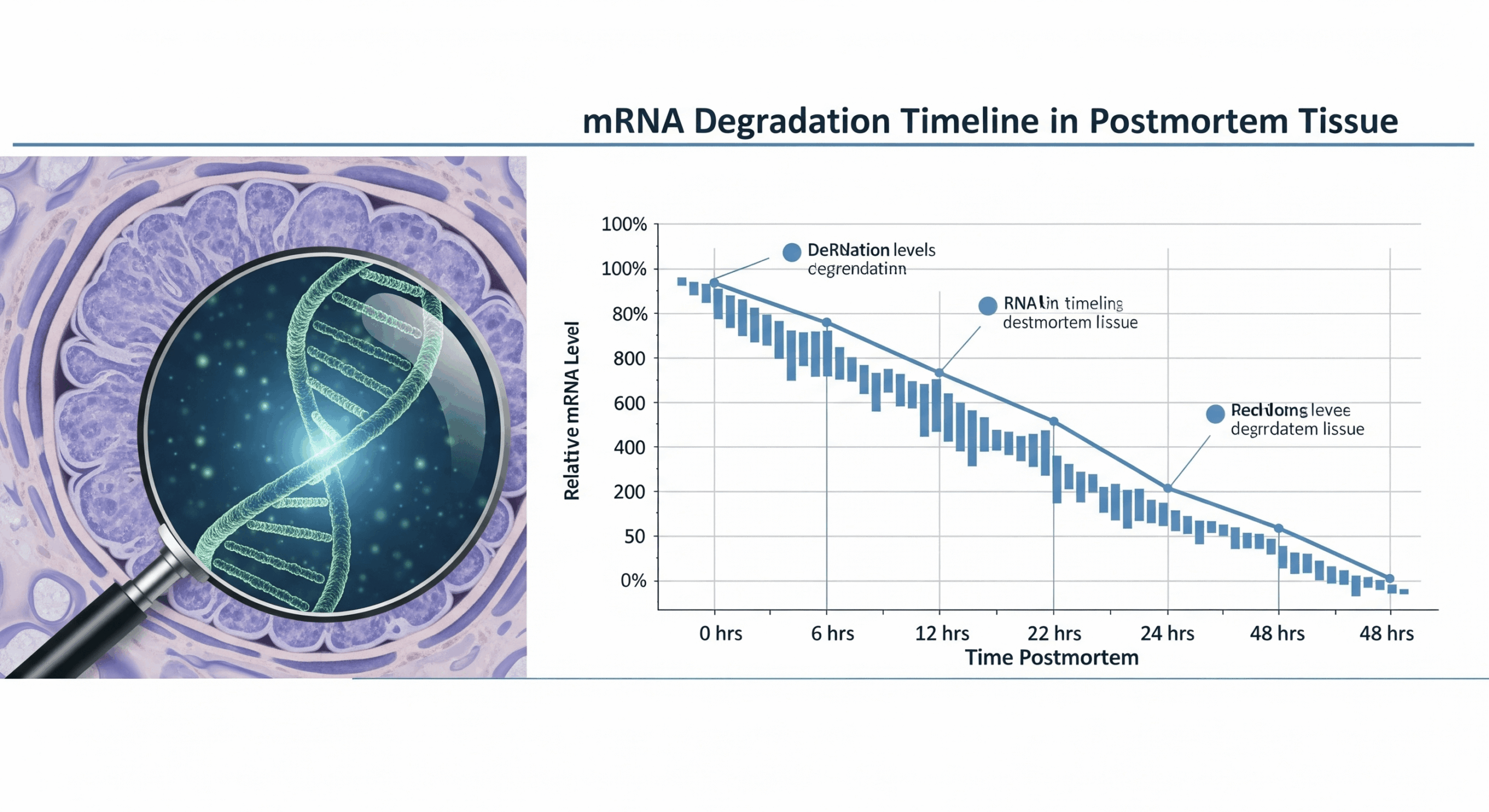In the immediate aftermath of death, the human body begins a series of predictable physical and chemical transformations. Among these post-mortem changes, postmortem staining, scientifically known as livor mortis or postmortem lividity (and sometimes referred to as postmortem hypostasis), is one of the most consistently observed and forensically valuable phenomena. This characteristic discoloration of the skin and internal organs occurs due to the gravitational settling of blood after circulation ceases.
- Mechanism of Formation: The Gravitational Principle
- Site of Occurrence: External and Internal Manifestations
- Phases and Progression of Postmortem Lividity: Dynamic Clues
- Onset Phase (Initial Appearance):
- Migration/Partial Fixation Phase (Up to 6-12 hours):
- Full Fixation Phase (10-12 hours onwards, extending up to 24-36 hours):
- Factors Affecting Postmortem Lividity: Modifying the Visual Evidence
- Medicolegal Importance of Postmortem Staining: A Forensic Imperative
- Conclusion: Postmortem Staining – A Silent Yet Eloquent Witness
For forensic pathologists and death investigators, understanding the intricate mechanism of livor mortis formation, its typical site of occurrence, the various factors that influence its appearance, and its medicolegal importance is absolutely essential. It serves as a vital tool for estimating the post-mortem intervalThe post-mortem interval (PMI) is the time that has elapsed since an individual's death. When the time of death is not known, the interval may be estimated, and so an estimated time of death is established. Read Full Definition (PMI) – the time since death – and, crucially, for determining whether a body has been moved after death. This comprehensive guide will delve into the science behind postmortem staining and its critical role in forensic investigations.
Mechanism of Formation: The Gravitational Principle
The formation of livor mortis is a direct consequence of the cessation of circulation at the moment of death, combined with the force of gravity:
- Cessation of Circulation: Upon cardiac arrest, the heart stops pumping blood throughout the body.
- Loss of Vascular Tone: The muscular walls of blood vessels, particularly the small capillaries and venules (part of the ‘rete mucosum’ or capillary network), lose their tone and relax.
- Gravitational Settling: With no active circulation and relaxed vessels, blood, influenced by gravity, begins to sink and pool in the capillaries and venules of the parts of the body that are lowest or most dependent.
- Discoloration: As the deoxygenated red blood cells accumulate in these dependent areas, they impart a purplish, reddish-purple, or bluish-purple discoloration to the overlying skin.
This process transforms the normal skin pallor into the characteristic staining of livor mortis.
Site of Occurrence: External and Internal Manifestations
Postmortem staining appears both externally on the skin and internally within the dependent parts of organs:
- External Appearance: The most visible manifestation is on the external surface of the body, specifically on the areas that are dependent (lowest) relative to gravity. For instance, in a body lying flat on its back (supine position), livor mortis will typically appear on the back, buttocks, and the posterior aspects of the limbs. If the body is found face down (prone position), lividity will be seen on the chest, abdomen, and front of the limbs.
- Internal Appearance: Internally, blood also gravitates to the dependent parts of all organs. For example, in a supine body, livor mortis will be visible in the posterior aspects of the lungs, kidneys, and brain.
- Contact Pallor (Blanching): Importantly, areas of the dependent parts that are in direct continuous contact with a hard surface (e.g., the ground, a bed, a tight collar, or clothing folds) do not show staining. The pressure from the surface compresses the capillaries, preventing blood from pooling. These areas remain pale, appearing as distinct, uncolored patches against the background of lividity. This phenomenon is known as Contact Pallor (or Pressure Pallor) and is a crucial forensic indicator.
Phases and Progression of Postmortem Lividity: Dynamic Clues
Livor mortis is not static. It progresses through distinct phases that are critical for PMI estimation and scene interpretation:
Once fully fixed, the lividity will not blanch with pressure, and it will not shift if the body’s position is changed. The original pattern of lividity remains, even if the body is subsequently moved. This “fixed lividity” is the definitive sign that the body was in a particular position during the crucial period of fixation.
Onset Phase (Initial Appearance):
Migration/Partial Fixation Phase (Up to 6-12 hours):
Full Fixation Phase (10-12 hours onwards, extending up to 24-36 hours):
Factors Affecting Postmortem Lividity: Modifying the Visual Evidence
While the mechanism of lividity is constant, several factors can significantly influence its appearance, intensity, distribution, and the speed of its formation and fixation. Ignoring these factors can lead to inaccurate medicolegal conclusions:
Time Since Death (PMI)
As detailed above, the progression from blanching to fixed lividity is a primary factor in estimating PMI.
Environmental Temperature
Blood Volume and Viscosity
Complexion of the Person
Cause of Death
Fixed and Undisturbed Positioning
The presence of clear, distinct patterns of lividity and contact pallor relies on the body remaining in an undisturbed position during the initial hours after death. If the body is frequently moved, the lividity patterns will be diffuse, faint, or multiple, complicating interpretation.
Medicolegal Importance of Postmortem Staining: A Forensic Imperative
Postmortem staining is not merely a curiosity; it is a vital sign in forensic pathology, offering critical information that directly impacts the course of an investigation:
- Definitive Sign of Death: The presence of livor mortis unequivocally confirms that circulation has ceased and that the individual is deceased.
- Estimation of Post-Mortem Interval (PMI): The sequential progression from onset, through migration, to complete fixation, allows forensic experts to provide a valuable estimation of the time that has passed since death. This is one of the key parameters used in conjunction with others like algor mortis and rigor mortis (as discussed in our articles: “Algor Mortis (Postmortem Cooling) and its Significance in Forensic Investigations“ and “Rigor Mortis: Mechanism, Stages & Forensic Significance“.
- Determination of Body Position After Death and Detection of Body Movement:
- The distribution of lividity directly indicates the position of the body during the initial hours of death.
- Crucially, suppose the patterns of lividity are inconsistent with the position in which the body is found (e.g., fixed lividity on the back, but the body is found face down). In that case, it provides irrefutable evidence

- Example: In cases of death by hanging, if the body remains suspended in an upright position for several hours, postmortem staining will be visible in the lower limbs, lower parts of the upper limbs, and, significantly, at the upper margin of the ligature mark on the neck (due to gravitation below the compression point).
- Providing Clues to Cause of DeathThe cause of death refers to the specific injury, disease, or underlying condition that directly leads to an individual's demise. It is a critical determination made by medical professionals, such as Medical Examiners or Coroners, Read Full Definition:
- The color of postmortem staining is a highly significant indicator for specific causes of death, particularly poisonings. The distinct colors associated with carbon monoxide, cyanide, and hydrogen sulfide poisoning, among others, can immediately alert investigators to the potential involvement of these substances, guiding subsequent toxicological analysis.
- The intensity and extent of lividity (e.g., intense, widespread lividity in asphyxial deaths) can also support certain hypotheses regarding the mechanism of death.
- Differentiating from Bruising:
- A key differential diagnosis for forensic pathologists is distinguishing lividity from bruising (contusions). Unlike bruising, fresh lividity will blanch with pressure (before fixation), and it does not typically show swelling or tissue discoloration within the skin layers that characterize a bruise. Fixed lividity, while non-blanching, still lacks the localized swelling and tissue disruption of a bruise.
Conclusion: Postmortem Staining – A Silent Yet Eloquent Witness
Postmortem staining, or livor mortis, is an indispensable aspect of forensic science
A meticulous examination of livor mortis patterns and characteristics is therefore fundamental for making valid medicolegal conclusions. By carefully analyzing this crucial post-mortem change, forensic professionals gain essential insights into the circumstances surrounding a person’s death, significantly contributing to the truth-finding mission of justice.
Key Points
- Mechanism of Livor Mortis Formation: Livor mortis occurs due to cessation of circulation, loss of vascular tone, gravitational settling of blood, and subsequent skin discoloration, typically within 30 minutes to 2 hours after death.
- Sites and Manifestations of Postmortem Staining: Postmortem staining appears externally on dependent body surfaces and internally within organs; contact with hard surfaces creates areas of pallor known as contact pallor, indicating pressure points during death.
- Phases and Fixation of Lividity: Lividity evolves through an onset, migration, and complete fixation phase, with fixation after 10-12 hours indicating the body remained in a particular position during early post-mortem intervals.
- Factors Influencing Lividity Appearance: Environmental temperature, blood volume, tissue complexion, cause of death, and body movement strongly influence the intensity, distribution, and fixation speed of livor mortis.
- Medico-Legal Significance of Postmortem Staining: Postmortem lividity confirms death, aids in PMI estimation, reveals body position or movement, provides clues to the cause of death, and helps distinguish lividity from trauma-related bruising.











